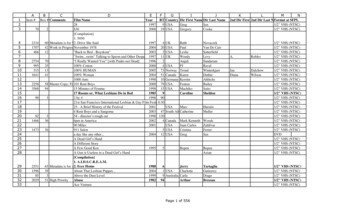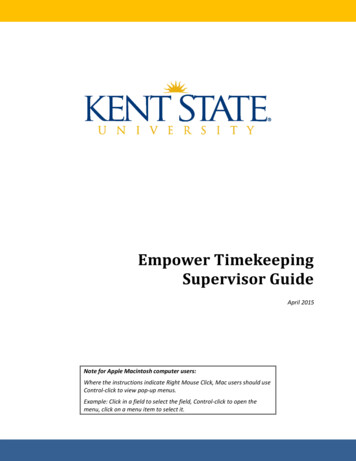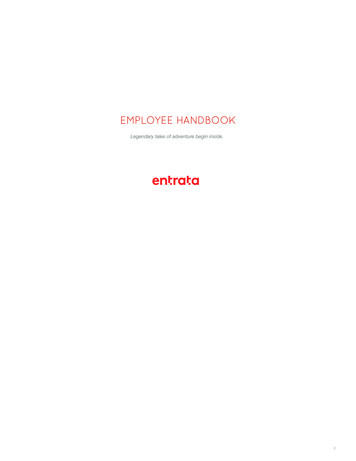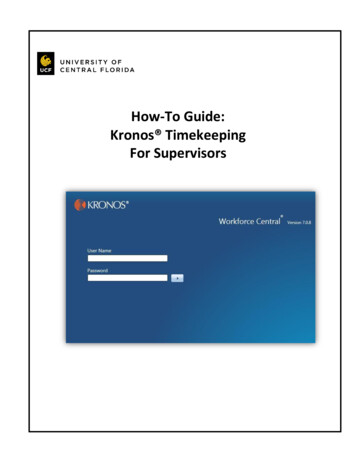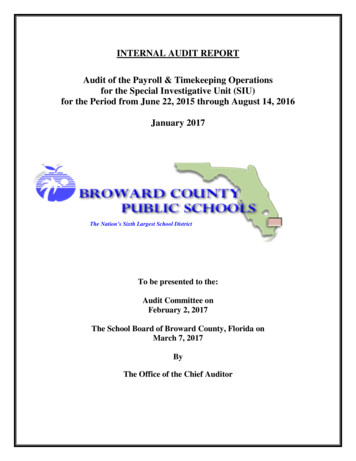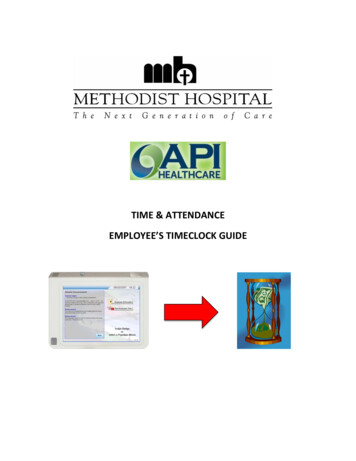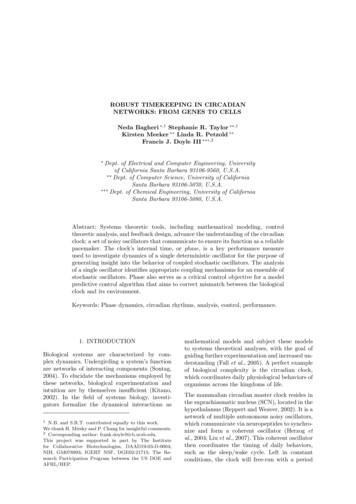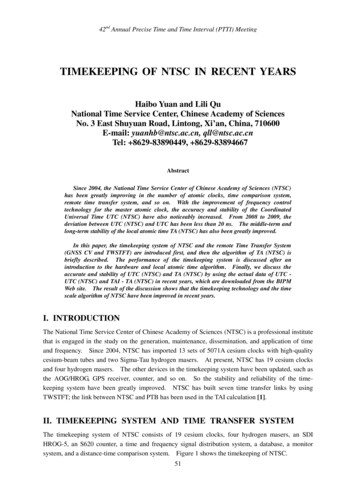
Transcription
42nd Annual Precise Time and Time Interval (PTTI) MeetingTIMEKEEPING OF NTSC IN RECENT YEARSHaibo Yuan and Lili QuNational Time Service Center, Chinese Academy of SciencesNo. 3 East Shuyuan Road, Lintong, Xi’an, China, 710600E-mail: yuanhb@ntsc.ac.cn, qll@ntsc.ac.cnTel: 8629-83890449, 8629-83894667AbstractSince 2004, the National Time Service Center of Chinese Academy of Sciences (NTSC)has been greatly improving in the number of atomic clocks, time comparison system,remote time transfer system, and so on. With the improvement of frequency controltechnology for the master atomic clock, the accuracy and stability of the CoordinatedUniversal Time UTC (NTSC) have also noticeably increased. From 2008 to 2009, thedeviation between UTC (NTSC) and UTC has been less than 20 ns. The middle-term andlong-term stability of the local atomic time TA (NTSC) has also been greatly improved.In this paper, the timekeeping system of NTSC and the remote Time Transfer System(GNSS CV and TWSTFT) are introduced first, and then the algorithm of TA (NTSC) isbriefly described. The performance of the timekeeping system is discussed after anintroduction to the hardware and local atomic time algorithm. Finally, we discuss theaccurate and stability of UTC (NTSC) and TA (NTSC) by using the actual data of UTC UTC (NTSC) and TAI - TA (NTSC) in recent years, which are downloaded from the BIPMWeb site. The result of the discussion shows that the timekeeping technology and the timescale algorithm of NTSC have been improved in recent years.I. INTRODUCTIONThe National Time Service Center of Chinese Academy of Sciences (NTSC) is a professional institutethat is engaged in the study on the generation, maintenance, dissemination, and application of timeand frequency. Since 2004, NTSC has imported 13 sets of 5071A cesium clocks with high-qualitycesium-beam tubes and two Sigma-Tau hydrogen masers. At present, NTSC has 19 cesium clocksand four hydrogen masers. The other devices in the timekeeping system have been updated, such asthe AOG/HROG, GPS receiver, counter, and so on. So the stability and reliability of the timekeeping system have been greatly improved. NTSC has built seven time transfer links by usingTWSTFT; the link between NTSC and PTB has been used in the TAI calculation [1].II. TIMEKEEPING SYSTEM AND TIME TRANSFER SYSTEMThe timekeeping system of NTSC consists of 19 cesium clocks, four hydrogen masers, an SDIHROG-5, an S620 counter, a time and frequency signal distribution system, a database, a monitorsystem, and a distance-time comparison system. Figure 1 shows the timekeeping of NTSC.51
Form ApprovedOMB No. 0704-0188Report Documentation PagePublic reporting burden for the collection of information is estimated to average 1 hour per response, including the time for reviewing instructions, searching existing data sources, gathering andmaintaining the data needed, and completing and reviewing the collection of information. Send comments regarding this burden estimate or any other aspect of this collection of information,including suggestions for reducing this burden, to Washington Headquarters Services, Directorate for Information Operations and Reports, 1215 Jefferson Davis Highway, Suite 1204, ArlingtonVA 22202-4302. Respondents should be aware that notwithstanding any other provision of law, no person shall be subject to a penalty for failing to comply with a collection of information if itdoes not display a currently valid OMB control number.1. REPORT DATE2. REPORT TYPENOV 2010N/A3. DATES COVERED-4. TITLE AND SUBTITLE5a. CONTRACT NUMBERTimekeeping of NTSC in Recent Years5b. GRANT NUMBER5c. PROGRAM ELEMENT NUMBER6. AUTHOR(S)5d. PROJECT NUMBER5e. TASK NUMBER5f. WORK UNIT NUMBER7. PERFORMING ORGANIZATION NAME(S) AND ADDRESS(ES)National Time Service Center, Chinese Academy of Sciences No. 3 EastShuyuan Road, Lintong, Xiâan, China, 7106009. SPONSORING/MONITORING AGENCY NAME(S) AND ADDRESS(ES)8. PERFORMING ORGANIZATIONREPORT NUMBER10. SPONSOR/MONITOR’S ACRONYM(S)11. SPONSOR/MONITOR’S REPORTNUMBER(S)12. DISTRIBUTION/AVAILABILITY STATEMENTApproved for public release, distribution unlimited13. SUPPLEMENTARY NOTESSee also ADA547222 . Precise Time and Time Interval (PTTI) Systems and Applications Meeting (42ndAnnual) Held in Reston, Virginia on November 15-18, 2010., The original document contains color images.14. ABSTRACTSince 2004, the National Time Service Center of Chinese Academy of Sciences (NTSC) has been greatlyimproving in the number of atomic clocks, time comparison system, remote time transfer system, and soon. With the improvement of frequency control technology for the master atomic clock, the accuracy andstability of the Coordinated Universal Time UTC (NTSC) have also noticeably increased. From 2008 to2009, the deviation between UTC (NTSC) and UTC has been less than 20 ns. The middle-term andlong-term stability of the local atomic time TA (NTSC) has also been greatly improved.15. SUBJECT TERMS16. SECURITY CLASSIFICATION OF:a. REPORTb. ABSTRACTc. THIS PAGEunclassifiedunclassifiedunclassified17. LIMITATION OFABSTRACT18. NUMBEROF PAGESSAR819a. NAME OFRESPONSIBLE PERSONStandard Form 298 (Rev. 8-98)Prescribed by ANSI Std Z39-18
42nd Annual Precise Time and Time Interval (PTTI) MeetingFigure 1 shows the time generation system, the comparison system, and the time application system; italso shows that the distance-time transfer technologies used by NTSC are GPS Common View (GPSCV) and Two-Way Satellite Time and Frequency Transfer (TWSTFT). Now there are five GPSreceivers that have been running for 5 years. Two of them are single-frequency (SF) GPS receivers,and the other three are double-frequency GPS receivers. Figures 2 and 3 show the data ofUTC (NTSC) – GPS (SF1) and UTC (JATC) – GPS (SF2).If the system difference between the UTC (NTSC) and UTC (JATC) is removed, then using the GPSCV to process the data, we can obtain the results in Figure 4, and the standard deviation of thedifference is 0.703927.The first TWSTFT by NTSC was established in the late 1990s between NTSC and NICT (CRL).Then NTSC continued studying TWSTFT. So far, NTSC has established eight TWSTFT links withNICT, NMIJ, PTB, TL, VSL (stopped), PSG (stopped), TL, KRISS, and so on. Figure 5 shows theTWSTFT NET between NTSC and other labs (the green line is the TWSTFT link).BIPM published the TWSTFT data between NTSC and PTB in the Circular T 257 in May 2009, andthen the TWSTFT data were used in the TAI calculation. Because of the malfunction of the satelliteIS8, the two-way links between NTSC and the European labs were interrupted in February 2010.Recently, the new link based on satellite AM2 has been established, and some experiments have beendone. The results before February 2010 are given in Figures 6 and 7.From Figures 6 and 7, we can find that the time transfer precision is up to the mustard. Theprecision is better than 0.5 ns, and the A-type uncertainty compared with UTC improved from 1.5 nsto 0.5 ns [2].The other time transfer systems include an NTP time service system, a telephone time transfer system,a long-wave time and frequency transfer (BPL), a short-wave time transfer (BPM), a BPC timeservice, and a satellite time service.III. ALGORITHM OF TA (NTSC)The time scale algorithm of TA (NTSC) is classical ALGOS [3]. The atomic clocks are located intwo places, one in Lintong where the headquarters of NTSC is located, and the other in Puchengwhere the radio stations division is located. The distance between Lintong and Pucheng is about 70km, and they are connected in real time with a microwave link. When calculating TA (NTSC),microwave time transfer and GPS CV are both used in the time comparison. Through the two timetransfer methods, we can take the clock data from the Pucheng radio station, and transmit the standardtime to the long-wave and short-wave radio station.IV. PERFORMANCE OF TIMEKEEPING SYSTEMThe timekeeping system of NTSC was set up in 1970s, and from then on, it has been continually52
42nd Annual Precise Time and Time Interval (PTTI) Meetingoperating for more than 30 years. In 2004, the system was updated, including the hardware andsoftware, and a new backup timekeeping system was set up in that year. Now the two timekeepingsystems are running simultaneously and they back up each other. Now, the master clock of the twosystems is a Sigma-Tau hydrogen maser numbered H226, which was imported from the USA in 2004.The master clock system of the two systems is shown in Figure 8.The performance of the master clock system is one of the key factors which directly affect the timekeeping performance. Before 5 December 2007, the master clock of the NTSC timekeeping systemwas H226; from 6 December 2007 to 3 November 2009, the master clock was cesium clock Cs2143;and on 4 November 2009, H226 was selected as the master clock again instead of Cs2143. Figure 9shows the performance of the master clock system when the master clock was H226 and Cs2143.Linear fitting the HDEV data, we find the slope of fitting line is -1; that is to say, the noise exhibitedby the master clock system is White PM or Flicker PM [2,4]. Comparing the two pictures in Figure9, we can find that the performance of the master clock system is affected by the master atomic clock,so we should select the best clock as the master clock.V. TAI-TA (NTSC) AND UTC-UTC (NTSC)According to the BIPM Circular T bulletin, there are 69 laboratories maintaining their UTC (k) andproviding their atomic data to the BIPM for the calculation of T AI. For 2009, the stability ofTA (NTSC) and that of the other important time labs are shown in Table 1.Part of the important timekeeping laboratories and its UTC – UTC (k) in 2009 are shown in Figure 10.Except for UTC (OP), the other labs’ UTC – UTC (k) are all within 40 ns.In 2009, the laboratories whose UTC-UTC(k) were less than 20 ns are AOS, NICT, USNO, NIST,NTSC, IT and NRL, and Figure 11 shows the results. From Figure 11, one can find that, though UTC – UTC (NTSC) is within 20 ns, its short-term stability is less than that of the other laboratories,because the control data are too acute. Now we are studying how to steer UTC (NTSC), and hope tomade UTC (NTSC) run smoothly.ACKNOWLEDGMENTSThe authors are very grateful for the assistance of Mrs. Zhang Hong and Mrs. Liu Chunxia. Mrs.Zhang provides the processed TWSTFT data and relative pictures. Mrs. Lin helps the authors lookup necessary information.REFERENCES[1] ]53
42nd Annual Precise Time and Time Interval (PTTI) Meeting[2] D. Howe, R. Beard, C. Greenhall, F. Vernotte, and W. Riley, 2001, “A Total Estimator of theHadamard Function Used for GPS Operations,” in Proceedings of the 32nd Annual Precise Timeand Time Interval (PTTI) Systems and Applications Meeting, 28-30 November 2000, Reston,Virginia, USA (U.S. Naval Observatory, Washington, D.C.), pp. 255-268.[3] H. Yuan, Z. Wang, and S. Dong, 2007, “Performance of hydrogen maser and its usage in localatomic time at NTSC,” in Proceedings of the Joint IEEE International Frequency ControlSymposium and 21st European Frequency and Time Forum (EFTF), 29 May-June 1 2007, Geneva,Switzerland (IEEE 07CH37839), pp. 889-892.[4] H. Yuan, 2008, “Analysis of main noise type of an atomic clock,” Journal of Instruments, 29 (8),187-191.Figure 1.The timekeeping system of NTSC.54
42nd Annual Precise Time and Time Interval (PTTI) Figure 2.MJD5550455505555065550755508UTC (NTSC) – GPS 0355504MJDFigure 3.55505555065550755508UTC (NTSC) – GPS -4-6-8-10Figure 4.The difference of the two GPS SF receivers.5555510
42nd Annual Precise Time and Time Interval (PTTI) MeetingFigure 5.TWSTFT link with NTSC.TW AR T-60549505500055050Figure 6.55100MJD551505520055250TWSTFT between NTSC and PTB.TW STFTUTC(NTSC)-UTC(OP)60TW : offset-3920.7CIRCULAR T504030ns20100-10-20-30-40549005495055000Figure 7.55050MJD55100TWSTFT between NTSC and OP.565515055200
42nd Annual Precise Time and Time Interval (PTTI) MeetingHROGCOUNTERH226COUNTERHROGFigure 8.The master clock system.Master clock: H226Figure 9.Master clock:Cs2143The performance of the master clock system.57
42nd Annual Precise Time and Time Interval (PTTI) MeetingTable 1. Stability of TA (k) (data from BIPM Web 510055150-40-60-80-100MJDFigure 10. Participating labs’ UTC – UTC (k) in 550005505055100-10-20-30MJDFigure 11. Labs’ UTC – UTC (k) 20 ns.58551505520055200
II. TIMEKEEPING SYSTEM AND TIME TRANSFER SYSTEM The timekeeping system of NTSC consists of 19 cesium clocks, four hydrogen masers, an SDI HROG-5, an S620 counter, a time and frequency signal distribution system, a database, a monitor system, and a distance-time comparison system. Figure 1 shows the timekeeping of NTSC.
